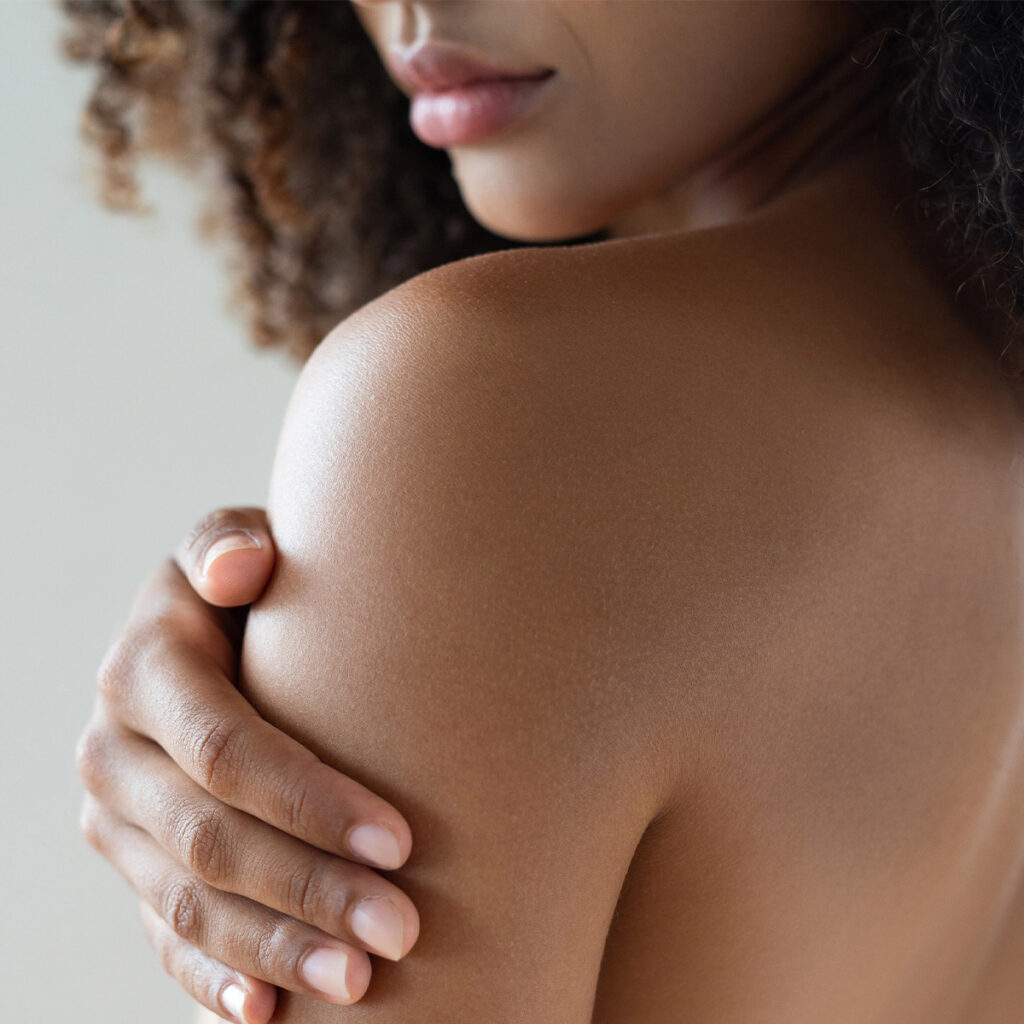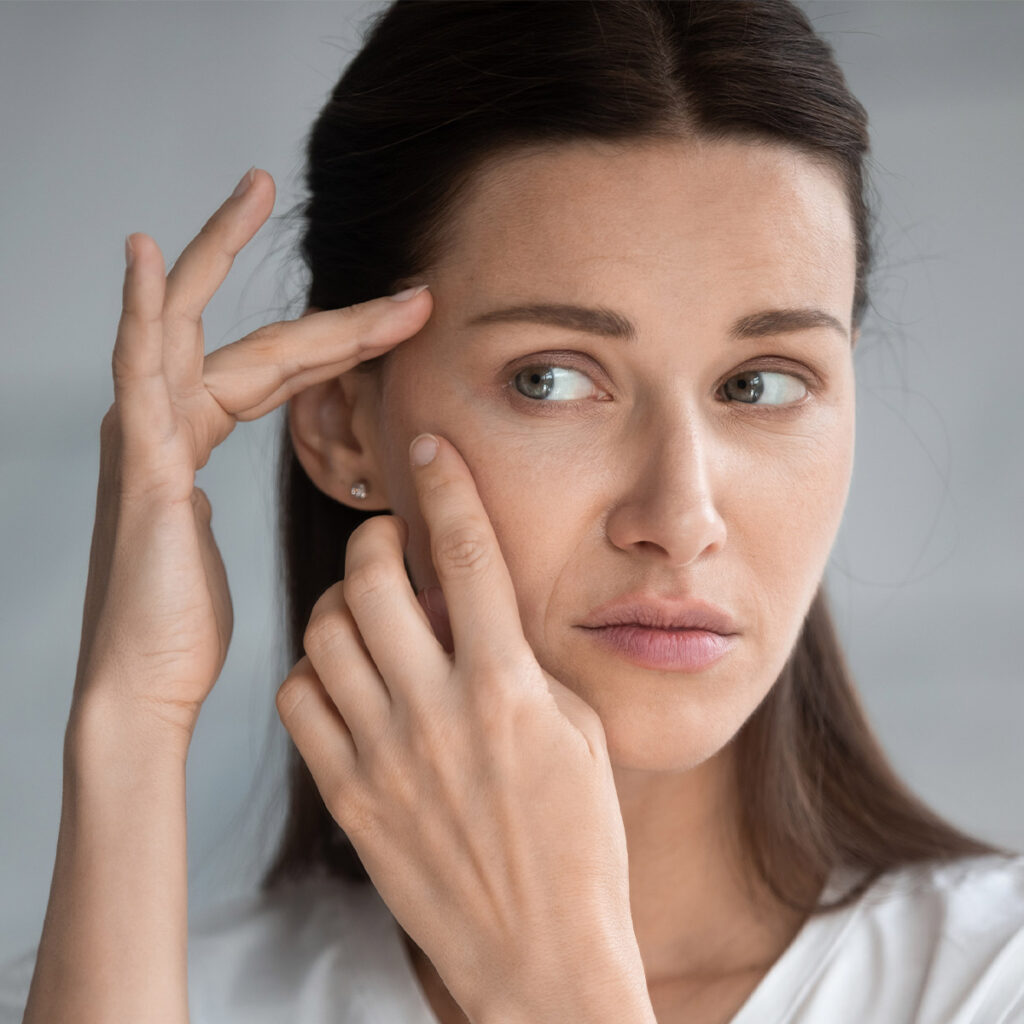The First Line Of Defense
The largest human organ is not located inside the body, but on the outside… the skin. For the average adult, skin covers roughly 3,000 square inches and weighs about 6 pounds, twice the weight of the human brain or liver. The skin is our first line of defense against infections, germs and pollutants. Amazingly, it is constantly changing and regenerates itself every 27 days, so an understanding of this organ and how it functions can help you protect your skin through daily care, diet and healthy lifestyle choices.
Skin is comprised of three layers. The outer layer, the epidermis, is the thinnest layer, yet protects skin from environmental damage. The epidermis is made up of five layers and three different types of cells: keratinocytes, which produce keratin, a tough protective protein that gives skin its rigidity and the main component of the epidermis; melanocytes, which produce melanin or skin pigment; and langerhans, which protect foreign substances from getting into the skin.
The middle layer of the skin, the dermis, is made up of a combination of blood vessels, hair follicles, oil glands and pain and touch receptors. The dermis also contains collagen and elastin, two proteins that provide support and elasticity.
The “fountain of youth” is contained in collagen, which is the most abundant protein in the skin. Collagen is necessary to ward off wrinkles and fine lines. However, the body’s ability to produce collagen diminishes with aging and exposure to environmental damage.

Elastin is responsible for the skin’s elasticity, suppleness and tone. It is also affected by the aging process and exposure to the environment. Lessened amounts of elastin will cause your skin to wrinkle and sag.
The third and most fatty layer, the hypodermis or subcutis, is responsible for conserving body heat and protecting vital inner organs. It contains sweat glands, fat and collagen cells. When the fatty tissue of the hypodermis degrades, skin will sag or hang more freely.
The network of elastin and collagen fibers loosen and unravel over time, causing depressions on the surface. Loss of elasticity with aging makes our skin less able to retain moisture and slow to heal, and oil-secreting glands become less efficient.
The loosening of elastin and collagen fibers causes wrinkles. Also, small facial muscle contractions, such as smiling, frowning and squinting cause wrinkles to become more prominent. However, it is exposure to ultraviolet radiation that is the number one cause of wrinkles and premature aging of the skin. Sun exposure damages collagen fibers and causes excessive production of abnormal elastin.
You can incorporate four proactive steps into your skin-care regimen that will lessen the development of wrinkles and contribute to healthy, beautiful skin: cleansing, exfoliating, moisturizing and protection. Cleansing helps rid the body of germs and other environmental substances.

A creamy cleanser is best if you have dry skin, a clear cleanser is best if you have oily skin. Avoid bar soaps as they tend to dry out the skin.
Exfoliation helps to remove the top layer of skin cells, which tend to dull the complexion. For best results, a monthly regimen of exfoliation is recommended. The skin can be exfoliated with microdermabrasion, chemical peels or retinoids. Microdermabrasion and chemical peels remove the top layer of skin cells, while retinoids generate collagen in the skin as well as exfoliate the skin. According to Dr. C. Rodney Susong, a Chattanooga dermatologist, tretinoin or Retin-A have the best track record for exfoliation and stimulating collagen.

Moisturizers seal moisture into the skin (the “saran wrap effect”). Your skin will tell you how much you should moisturize. If your skin feels tight, it needs moisture, but be careful not to over moisturize, as this can clog pores.
Finally, top skin care experts and dermatologists say protection from the sun is the most important part of skin care. Dr. Susong says, “You cannot start a conversation about skin care without talking about sunscreen.” You should incorporate applying sunscreen or lotion with a minimum SPF 15 to 30 into your daily skin care routine. It is possible to moisturize and protect at the same time if you buy a moisturizer with sunscreen. Although, moisturizers with UV protection should only be used during the day, as the ingredients are not meant to be used continuously and can aggravate the skin. Sun exposure over a lifetime not only can cause wrinkles, but also freckles; age spots; rough, dry skin and more serious problems such as skin cancer.
Skin care has come a long way – it is no longer about simply washing and moisturizing the face. Almost daily we are bombarded with media buzz words such as “free radicals,” “antioxidants” and “alphalipoic acid” that promise to reduce wrinkles, provide younger looking skin or erase fine lines and wrinkles. Dr. Susong notes that the practice of dermatology has changed over the years, adding that dermatology now focuses more on skin care versus treatment of skin problems.
Being educated about skin care ingredients will help you select which ones are best for your skin. Many products contain ingredients found naturally in the body, but age, smoking and an unhealthy diet can compromise the body’s ability to keep producing those ingredients over time. Alpha-hydroxy acids (AHA’s) are natural based acids such as glycolic, lactic, citric, and tartaric acid. They are used to exfoliate the skin, reduce fine lines and wrinkles, age spots, acne scars and irregular pigmentation.
Antioxidants are natural substances made up of vitamins and minerals. They have been shown to repair damage and slow the aging process by fighting free radicals, which are unstable substances that attack human cells and damage DNA. Free radicals can be found in the air we breathe, the foods we eat, sunlight and pollution.
There is a way to fight free radicals. Antioxidants are the answer, either by eating foods rich in them or by applying them to the skin. Some antioxidants found in skin care products include: acai oil, alpha-lipoic acid, retinol (a derivative of Vitamin A), Vitamin C, Co-Enzyme Q-10 (CoQ-10) and hyaluronic acid. Not only do antioxidants protect skin from free radicals, they stimulate collagen production and minimize fine lines and wrinkles by plumping the skin. Some antioxidants can improve skin tone and color, and reduce hyperpigmentation (dark spots).
Topical solutions certainly help the overall look and feel of your skin but for optimal skin health, the true test is what goes in your body not on your body. So don’t just beautify your skin, nourish it.
Pam Kelle, a registered dietician and nutritional therapist says, “I can tell you from years of practice, that I can look at someone and pretty quickly determine from visual observation if they are consuming good, fresh, wholesome foods. Conversely, someone who lives solely on processed and fast foods often has a dullness or sallowness to their skin.”
The less we pay attention to what goes in our mouth, the more skin problems we will have. Eating a balanced diet is the best way to ensure you are getting the foods necessary for healthy skin. “There is more evidence everyday that antioxidants and phytochemicals found in whole foods play a major role in the aging of skin, hydration and vibrant looking skin. We need to look at foods with a new respect of how they affect the skin,” says Kelle.


Lifestyle is another contributing factor for healthy skin. The number one lifestyle change you can make to help your skin is to not start smoking and to stop if you already are a smoker. Smoking makes the skin look older as it narrows tiny blood vessels in the outermost layers, which decreases blood flow. Smoking also damages collagen and nutrients that are important to skin health.
A good exercise routine infuses skin cells with oxygen as well as other nutrients, which are ideal conditions for collagen production. Exercising also has added benefits – it tones and conditions muscles and helps remove toxins. It can relax your body, including the muscles in your face, helping to soften crow’s feet and anger expression lines. Additionally, aerobic exercise has a detoxifying effect on the skin, which helps to remove toxins such as cigarette smoke and pollution.
Our skin is the body’s main line of defense against disease and the external environment. So, get comfortable in your skin and protect it with daily care, a healthy diet and good lifestyle choices. Not only will you look good, you’ll feel better.
Rebecca Rochat
Rebecca Rochat is a resident of Chattanooga. She attended the University of Tennessee where she earned a BS in Child Development and MS degree in Textiles and Merchandising and Design. In addition to freelance writing, Rebecca serves as an adjunct instructor at the University of Tennessee at Chattanooga.
